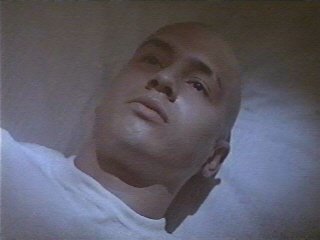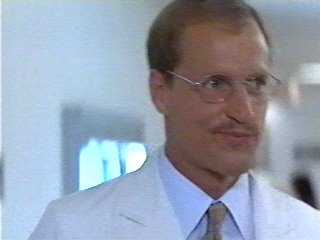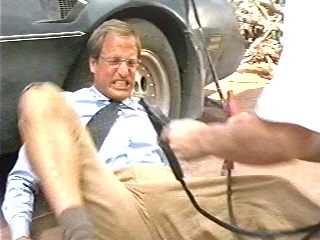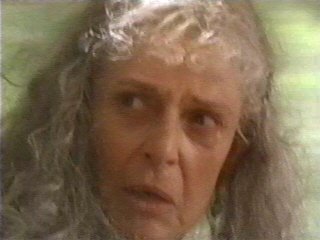
|
|
|
|
|
|
|
|
|
|
|
|
|
(a.k.a. The Sunchaser) (1996) Director: Michael
Cimino
Throughout Hollywood history there have always been a few so-called "bad boys" working as directors. Some of these directors have been given this label because of their intent to shock (like John Waters did with movies like Pink Flamingoes and Desperate Living) or sneaking in a personal philosophy in their works that isn't exactly welcomed by many audience members, in the vein of what Sam Peckinpah did in movies like Straw Dogs. Then there are those directors who were notorious for their descent into self-indulgence and wretched excess, which often ended up mostly or completely destroying their directorial careers sooner or later - Erich Von Stroheim, for one. Michael Cimino is another such director, though his directorial career before disaster hit was nowhere as long as Von Stroheim's. Many people will know this disaster or have some inkling of it by the mention of two words: Heaven's Gate. Not only was the movie a huge critical and financial disaster, Cimino's strong penchant towards excess while making it ended up bankrupting United Artists. (Though UA itself shares a lot of the blame for its demise for doing essentially nothing during filming to stop Cimino from overspending.) I am sure a lot of people don't know what happened to
Cimino after this debacle, and may be curious to know if he was ever
able to There is one other post-Heaven's Gate effort of his, which also happens to be his last directorial effort to date: Sunchaser, which he also produced. Never heard of it? Well, this web site is called "The Unknown Movies" for a reason. Seriously, the reason why you haven't heard of it is that its North American distributor (Warner Brothers) gave it virtually no theatrical release, probably only giving it that tiny release at all so it could fulfill a contractual clause requiring that it have some kind of theatrical release. Clearly, WB had no confidence in the movie at all, and after watching it for myself, I had a pretty good idea why they felt that particular way. Overall Sunchaser is an extremely big mess, not only made up of a collection of poor or half-baked ideas, but all connected together with the finesse of a car driver speedily driving from idea to idea with seeming little idea of any logical route to follow, and along a rough and difficult-to-manoeuvre surface equal to that of the desert location the movie's two protagonists find themselves traveling across. Apparently, Cimino's habit of leaping into the creation of a movie to fulfill various and sudden whims without previously taking the time to think about them carefully - or the actual script itself - didn't die with Heaven's Gate after all. It must be noted that the movie does have some good moments, but when you see the quality of the material surrounding these moments, they seem to more come out of accident than from any lapses into good judgment. I can imagine that Woody Harrelson was attracted to this project by the fact that it was a rare chance to play a serious role (and without irony or parody, as in Natural Born Killers.) His character is Michael Reynolds, an L.A. oncologist who has achieved great success, not only owning a $175,000 sports car which he oh-so-happily drives to work, but when the movie starts is currently anticipating a promotion in the hospital, as well as negotiating for a new multi-million dollar home for himself and his family. You guessed it - all this happiness and personal success of his can only mean that somewhere along the way he forget his humanity and sensitivity, which is confirmed in an early scene where he steps out of a session with one of his cancer patients to talk to his wife for less than a minute about their present bid for their new home. (At least, for a change, this familiar stereotype is not neglectful of his family.) Naturally, he will need not only be taught several
lessons about life and what are Personally, I find it a bit difficult to believe that someone we quickly learn has been hardened by years of urban life and from committing multiple major felonies (including the murder of his stepfather) could all of a sudden have a strong belief in things of a mystic vein and be uttering mantras like "May beauty be before me / May beauty be behind me". Though since desperate times often find themselves solved by desperate measures, I guess it's possible a homicidal punk could eventually find himself transformed into this way of thinking, especially with the realization that he has a disease that will kill him very soon... just not this particular homicidal punk. This is not a criticism of Jon Seda's performance; though past his teenage years when he took on this role, he is very believable as a hardened foul-mouthed gangbanger. Blue is a punk who has seen and experienced so much absolute poison in his short lifetime that everything he does and says conveys an animal-like rage within him. Even during his calmer moments you sense that the slightest thing could set him off, and when he grabs a gun and presses it against somebody's head, this action is not only utterly convincing, you really believe he could kill someone without the slightest thought about it afterwards. Seda does all this and everything else given to him nothing less than top-notch, so any problems the movie has definitely does not come from him. The problem that I had with the character of Blue was
that I couldn't believe that he had developed such spiritual beliefs
that I mentioned earlier. Being locked up in maximum security and
dealing both with the physical Not only is it unbelievable that Blue has a spiritual belief while having an utter contempt towards humanity simultaneously, it is equally implausible that his character undergoes a transformation that makes him "nice" (or more exactly, less annoying and threatening than usual)... at least a transformation that is as quick and sudden as the one here. In fact, in some ways it is hard to call it a transformation because there is no visible evolution between his initial ornery manner to his subsequent more tolerable attitude. One minute he is being his usual fierce self, and then, for no real reason at all, he is more sedate and stays that way for the rest of the movie. Dr. Reynolds himself also goes through a unexplainable transformation at this point of the movie; he finally finds himself free to go after a couple of days of non-stop terror and abuse, and what does he do? Well, I could believe that he would seek medical attention for Blue when his condition turns bad at one point - he is a doctor after all, sworn to heal everyone? But to not only rob a hospital at gunpoint for medical supplies but being now a willing chauffeur who wants to take Blue to this secret location in the middle of nowhere? I don't buy that any doctor would do this, not even Dr. Reynolds, who we learn very little about. It is revealed that his brother died of cancer when he was a boy, but this fact (and the several minutes of black-and-white flashbacks of it) in the end don't seem to do anything. It's not surprising that with to play such a weakly constructed character, Harrelson is wildly inconsistent with his performance. When his character is first seen, starting work for the day at the hospital and talking shop with his fellow doctors, Harrelson almost seems to be playing it for laughs and this whole serious-minded sequence as a result plays like a bad parody. Other moments later in the movie, like his frantic prayer to God, are equally laughable and can't be taken seriously. In general, though, Harrelson plays Dr. Reynolds as too high-pitched, both in voice and attitude; you would expect someone who has worked his way to becoming such a respected physician to be more weathered, more professional. There are some scenes when Harrelson does find the right note for Dr. Reynolds. Surprisingly they are the most challenging scenes, whenever his character gets face-to-face with Blue in a mutual explosive rage. Though the armed Blue clearly has the upper hand in these confrontations and Dr. Reynolds never dares to push things too far, Harrelson still manages to hold his own, doing very well in showing Reynolds' fear, rage, and struggle to find a common ground. Both actors help to makes these verbal battles the best scenes in the movie. Though a number of these confrontations end up giving little or no advance to the story, they are compelling all the same. Cimino's direction of these verbal battles also is a big
reason why they have such impact; even when the characters are not as
vocal with their threats and insults, there is a violent feeling in the
atmosphere that makes you think things could Not only is there a lot of material presented in a similarly inappropriate way, there is a lot of other material that was simply poorly conceived even before Cimino got his hands on it. The third-billed Anne Bancroft actually just appears once, a bizarre scene that serves absolutely no purpose, where she meets the two leads and utters some mystical mumbo-jumbo before fading into the dust of the horizon. Other unexplainable things include the development of the police thinking that Reynolds was actually behind the kidnapping (despite the fact it happened in front of a policeman) and when Reynolds' mother arrives in L.A. to comfort her daughter-in-law and granddaughter... and not only ends up doing nothing, I don't think she even got to say one word of dialogue. There are other curious thinks like Reynolds' mother that strongly suggest that despite the movie's present length (over two hours), it originally had a running time that was much longer. It's possible a resurrected longer version might fill in these missing gaps, but it would do little to compensate for Sunchaser's other deficiencies. If Cimino believed that this poorly-conceived story would resurrect his fallen career, well, he was chasing rainbows.
Check for availability on Amazon (VHS) See also: Breezy, Rabid Dogs, Your Three Minutes Are Up |
 return to directing,
whether in Hollywood or elsewhere. Although he has managed to more or
less continue his filmmaking career since Heaven's Gate,
he has not managed to really regain any of the status he lost after
that movie. His behavior has gotten him removed from some projects
before shooting started (like
Footloose), and this behavior of his may have
played a part in some other projects of his being completely cancelled.
His projects that did get completed and he managed to stay with didn't
make any real difference to his career. Not only has he had the
misfortune to direct Mickey Rourke three times, each project
was a disaster for him; his direction on The Pope Of Greenwich
Village didn't get a screen credit, Year Of The Dragon
got an iffy reaction from critics and the box
office, and his remake of
Desperate Hours... well, the less said about
it, the better. There was also The Godfather wannabe The
Sicilian, which critically and financially did just about as
well as Desperate Hours.
return to directing,
whether in Hollywood or elsewhere. Although he has managed to more or
less continue his filmmaking career since Heaven's Gate,
he has not managed to really regain any of the status he lost after
that movie. His behavior has gotten him removed from some projects
before shooting started (like
Footloose), and this behavior of his may have
played a part in some other projects of his being completely cancelled.
His projects that did get completed and he managed to stay with didn't
make any real difference to his career. Not only has he had the
misfortune to direct Mickey Rourke three times, each project
was a disaster for him; his direction on The Pope Of Greenwich
Village didn't get a screen credit, Year Of The Dragon
got an iffy reaction from critics and the box
office, and his remake of
Desperate Hours... well, the less said about
it, the better. There was also The Godfather wannabe The
Sicilian, which critically and financially did just about as
well as Desperate Hours.
 the most important things about it during a long and hard
journey, but learn all this from someone who is a complete opposite
from him - most likely someone who is of a different ethnicity. That
someone in this case is Brandon "Blue" Monroe (Seda, from the
TV shows Oz and Homicide), a 16 year-old half-Navajo
gangbanger youth who is not only incarcerated for murder and armed
robbery, but has been stricken with retroperitoneal sarcoma and only
has a couple of months to live. The two meet at the hospital when Blue
is brought in for treatment and Michael is assigned to be his doctor.
As expected, the two of them don't exactly get along, and the tension
between them just increases when Blue manages to get a hold of a gun
and kidnap Michael, forcing him to drive the two of them out of L.A.
Though the journey doesn't end once that happens; Blue forces Michael
to drive on out of California into Arizona, for reasons he initially
keeps to himself but eventually reveals. Having remembered his exposure
to his Navajo heritage during his imprisonment, Blue wants to be taken
to a mountaintop lake a medicine man told him about when he was
younger, a special lake that reportedly has the power to heal people
even with supposedly uncurable illnesses.
the most important things about it during a long and hard
journey, but learn all this from someone who is a complete opposite
from him - most likely someone who is of a different ethnicity. That
someone in this case is Brandon "Blue" Monroe (Seda, from the
TV shows Oz and Homicide), a 16 year-old half-Navajo
gangbanger youth who is not only incarcerated for murder and armed
robbery, but has been stricken with retroperitoneal sarcoma and only
has a couple of months to live. The two meet at the hospital when Blue
is brought in for treatment and Michael is assigned to be his doctor.
As expected, the two of them don't exactly get along, and the tension
between them just increases when Blue manages to get a hold of a gun
and kidnap Michael, forcing him to drive the two of them out of L.A.
Though the journey doesn't end once that happens; Blue forces Michael
to drive on out of California into Arizona, for reasons he initially
keeps to himself but eventually reveals. Having remembered his exposure
to his Navajo heritage during his imprisonment, Blue wants to be taken
to a mountaintop lake a medicine man told him about when he was
younger, a special lake that reportedly has the power to heal people
even with supposedly uncurable illnesses. effects of his
disease and the knowledge that he was being slowly killed by it does
not seem to have affected his character at all. For most of the movie
he comes across in the most vicious, callous, and self-centered way you
can imagine. It's not that he constantly comes across in this manner
from any internal feelings of desperateness - I could believe that, and
his sadistic behavior would have been easier to digest knowing that he
was suffering inside - it's that the screenplay generally depicts him
as being mean for mean's sake. He has a virtual giggle in his demeanor
as he slaps Dr. Reynolds around, threatening to blow off his "cap" and
using crude kinds of psychology to torture him. And this same person is
supposed to have regrasped a spiritual part of his heritage? I don't
buy it. Not only is Blue's behavior unbelievable for someone believing
and seeking spiritual comfort of some sort, it turns off any interest
we might have had for his quest. Do we care about finding out if an
unredeemed and often cruel excuse for a human being manages to complete
a great quest of this nature? I don't know about you, but I certainly
don't.
effects of his
disease and the knowledge that he was being slowly killed by it does
not seem to have affected his character at all. For most of the movie
he comes across in the most vicious, callous, and self-centered way you
can imagine. It's not that he constantly comes across in this manner
from any internal feelings of desperateness - I could believe that, and
his sadistic behavior would have been easier to digest knowing that he
was suffering inside - it's that the screenplay generally depicts him
as being mean for mean's sake. He has a virtual giggle in his demeanor
as he slaps Dr. Reynolds around, threatening to blow off his "cap" and
using crude kinds of psychology to torture him. And this same person is
supposed to have regrasped a spiritual part of his heritage? I don't
buy it. Not only is Blue's behavior unbelievable for someone believing
and seeking spiritual comfort of some sort, it turns off any interest
we might have had for his quest. Do we care about finding out if an
unredeemed and often cruel excuse for a human being manages to complete
a great quest of this nature? I don't know about you, but I certainly
don't.  quickly go to hell.
The standout sequence is in the diner, where customers just feet away
are oblivious to Blue holding a gun on Reynolds, and nearby are some
bikers that clearly Reynolds wonders could be used to his advantage...
or maybe just end up aggravating the situation even further. There is
also a natural feeling to this scene as well, a natural feeling
uncommon in Hollywood movies that makes this situation feel more real
instead of being shot on a constructed set and the action
choreographed. You also sense that same interesting feel in other
sequences, like when Blue and Reynolds find themselves in the middle of
an unrelated crowded crime scene on their way out of Los Angeles.
Cimino adds a few other nice touches here and there, like some
spectacular American southwest landscapes (nicely photographed by
Douglas Milsome); it's unfortunately there is currently no letterboxed
edition of this movie available in order to be able to fully appreciate
it. Unfortunately, for every personal touch Cimino makes on
Sunchaser that could be considered both appropriate and
professionally done, he makes at least three or four serious
miscalculations, sometimes of such a grand nature that it's hard to
imagine even a truly incompetent director like Albert Pyun would do
them. Clearly Sunchaser was written with the intent to
be a serious human drama, so why does the movie open with the prison
transport taking Blue to his regular checkup not only speeding at
breakneck speed along the L.A. freeway, but with its siren shrieking
and its lights flashing? Not only that, but with military-sounding
music (provided by composer Maurice Jarre) drumming away as the opening
credits also simultaneously play out, written in a font that would be
more appropriate for Miami Vice.
quickly go to hell.
The standout sequence is in the diner, where customers just feet away
are oblivious to Blue holding a gun on Reynolds, and nearby are some
bikers that clearly Reynolds wonders could be used to his advantage...
or maybe just end up aggravating the situation even further. There is
also a natural feeling to this scene as well, a natural feeling
uncommon in Hollywood movies that makes this situation feel more real
instead of being shot on a constructed set and the action
choreographed. You also sense that same interesting feel in other
sequences, like when Blue and Reynolds find themselves in the middle of
an unrelated crowded crime scene on their way out of Los Angeles.
Cimino adds a few other nice touches here and there, like some
spectacular American southwest landscapes (nicely photographed by
Douglas Milsome); it's unfortunately there is currently no letterboxed
edition of this movie available in order to be able to fully appreciate
it. Unfortunately, for every personal touch Cimino makes on
Sunchaser that could be considered both appropriate and
professionally done, he makes at least three or four serious
miscalculations, sometimes of such a grand nature that it's hard to
imagine even a truly incompetent director like Albert Pyun would do
them. Clearly Sunchaser was written with the intent to
be a serious human drama, so why does the movie open with the prison
transport taking Blue to his regular checkup not only speeding at
breakneck speed along the L.A. freeway, but with its siren shrieking
and its lights flashing? Not only that, but with military-sounding
music (provided by composer Maurice Jarre) drumming away as the opening
credits also simultaneously play out, written in a font that would be
more appropriate for Miami Vice.